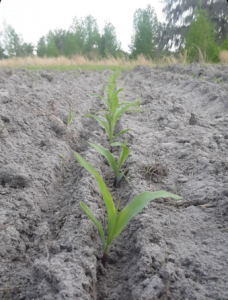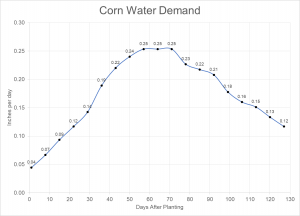Jay Capasso, UF IFAS Columbia County Extension, De Broughton, UF IFAS North Florida Research and Education Center-Suwannee Valley
Field corn planting season is underway in Columbia County. Generally field corn is planted between late February and April. Germination of field corn requires morning soil temperatures of 55° F or above at 2 inch depth for three consecutive days. For irrigated field corn, the benefits of planting early include increased soil moisture, increased yield potential, longer day lengths/lower temperatures during pollination, harvest prior to peanuts, and reduced insect and disease pressure. Dryland corn may benefit from planting in late April if typical seasonal rainfall occurs June – August. Dry periods can occur for three weeks or more during the growing season especially in April and May putting dryland corn at risk.

Water and Irrigation
Water is the greatest yield limiting factor in the region. Plant health can be limited by excess or lack of water. The most critical period for irrigation is tasseling through ear fill. Excess irrigation can limit plant health through leaching nutrients and potentially increasing disease pressure. Soil moisture sensors are a great tool to optimize irrigation scheduling. See link at the bottom of the page for information on agricultural cost share available for soil moisture sensors through the Suwannee River Water Management District.
Check uniformity of irrigation systems, especially when applying nitrogen through the pivot. There are mobile irrigation lab evaluations available through agency cost share programs to evaluate irrigation uniformity. Pivots showing less than 80% uniformity should be retrofitted.

Nutrients
Always soil test to inform nutrient management decisions. If soil samples are sent to a private laboratory ask for the Mehlich 3 extraction, especially if you are enrolled in the BMP program. If chicken litter is applied, get the material tested from the UF Waste Testing Laboratory or a private laboratory to determine nutrient content. Conduct tissue sample tests between the vegetative and early reproductive stages to determine the status of nutrient uptake.
In Columbia County, many of our soils test high in phosphorus. Soil fungi involved in phosphorus uptake are less active early in the season when soils are cold. In high phosphorus soils only apply phosphorus in the starter application up to 15 lbs per acre.
In Columbia County’s sandy soils nitrogen leaches quickly during heavy rainfall events. Split applications of nitrogen fertilizer are recommended to increase nitrogen use efficiency. Overhead irrigation allows for nitrogen to be applied later in the season through the pivot. No yield increases have been found in applications of nitrogen after the silk and tassel stage.
Fertilizer placement is important. Banding or sidedressing fertilizer can result in increased efficiency. You can apply about 30% less fertilizer when you sidedress or band fertilizer applications compared to broadcasting.
Nematodes and Plant Disease
Nematodes are often problematic in Columbia County due to our sandy soils and short rotations. Rotating field corn with peanut is beneficial for controlling certain parasitic root knot nematodes such as the southern and peanut root knot nematodes, but will not help with some other types of root knot nematode such as the Javanese root knot nematode. Sting nematodes are difficult to manage using crop rotation due to their wide host range. Parasitic nematode populations can be sustained on weed hosts. Managing weeds can help reduce nematode pressure. If you are unsure whether to apply a nematicide contact the Columbia County Extension office for information on soil sampling and available testing through the UF IFAS Entomology and Nematology department’s Nematode Assay lab (at the time of this writing we are limited in what services we can provide due to COVID-19 precautions). Scout crop regularly to monitor plant diseases. Apply fungicides if needed based on scouting.
Please see links below for additional information:
UF/IFAS Field Corn Production Guide:
http://edis.ifas.ufl.edu/pdffiles/AG/AG20200.pdf
UGA Field Corn Production Guide
https://grains.caes.uga.edu/content/dam/caes-subsite/grains/docs/corn/2020-Corn-Production-Guide.pdf
UF IFAS Field Corn Nematode Management:
https://edis.ifas.ufl.edu/ng014
Suwannee River Water Management Agricultural Cost Share Options:
http://www.srwmd.org/366/Agricultural-Cost-Share-Program
 0
0
